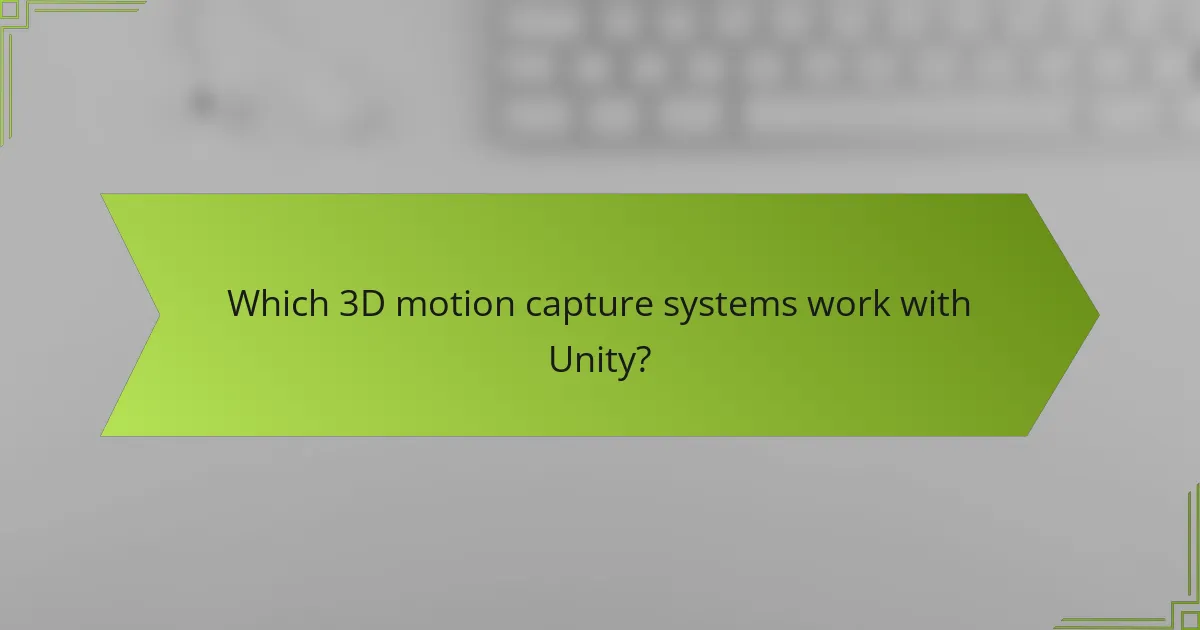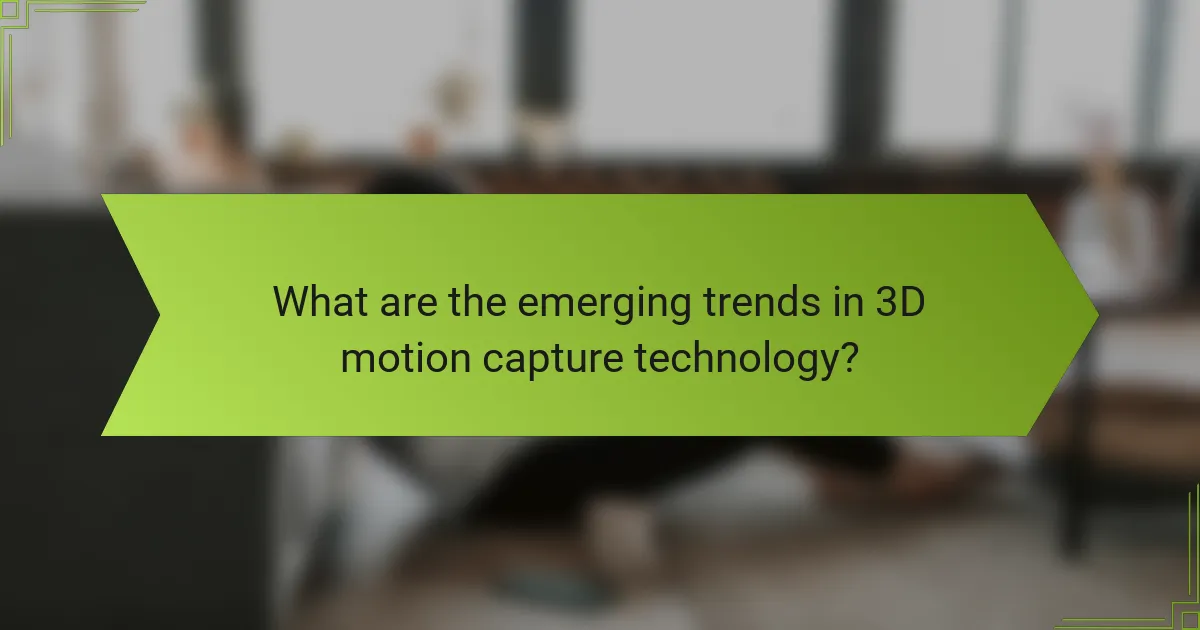3D motion capture equipment plays a crucial role in enhancing animation workflows by providing realistic movement data compatible with popular software like Autodesk Maya, Blender, and Unity. Systems such as Vicon Vantage and Rokoko Smartsuit Pro enable seamless integration, allowing animators to import and refine motion data directly within their preferred platforms. This compatibility not only streamlines the animation process but also elevates the quality of character movements in various projects.

What 3D motion capture equipment is compatible with Autodesk Maya?
Several 3D motion capture systems are compatible with Autodesk Maya, allowing for seamless integration of motion data into animation projects. Key systems include Vicon Vantage and OptiTrack Motive, both of which offer robust features for capturing motion and exporting it directly into Maya.
Vicon Vantage
Vicon Vantage is a leading motion capture system known for its high precision and flexibility. It utilizes advanced camera technology to capture motion in real-time, making it suitable for both film and game development. When using Vicon Vantage with Autodesk Maya, users can expect a straightforward workflow, as the system provides plugins that facilitate easy data transfer.
To maximize compatibility, ensure that you are using the latest version of both Vicon software and Maya. Regular updates often include enhancements that improve integration and performance. Additionally, consider the number of cameras needed; a typical setup might require anywhere from 8 to 16 cameras depending on the complexity of the capture environment.
OptiTrack Motive
OptiTrack Motive is another popular choice for motion capture, offering high-quality tracking and a user-friendly interface. It supports various capture methods, including marker-based and markerless tracking, which can be beneficial depending on your project’s requirements. The integration with Autodesk Maya is facilitated through a dedicated plugin, allowing for efficient data import and manipulation.
When setting up OptiTrack Motive, pay attention to the calibration process to ensure accurate tracking results. Users typically find that a setup with 6 to 12 cameras provides sufficient coverage for most applications. Additionally, consider the lighting conditions in your capture space, as optimal lighting can significantly enhance tracking accuracy.

How does 3D motion capture integrate with Blender?
3D motion capture can seamlessly integrate with Blender, allowing animators to create realistic character movements. By using compatible motion capture equipment and plugins, users can import motion data directly into Blender for further editing and refinement.
Perception Neuron
Perception Neuron is a popular motion capture system known for its affordability and ease of use. It utilizes inertial sensors to capture motion data, which can be exported to Blender using a dedicated plugin. This system is particularly suitable for indie developers and small studios looking to achieve high-quality animations without a significant investment.
When using Perception Neuron with Blender, ensure that you have the latest version of the plugin installed. A common pitfall is failing to calibrate the sensors properly, which can lead to inaccurate motion data. Regularly check for software updates to maintain compatibility and performance.
Xsens MVN
Xsens MVN is a professional-grade motion capture solution that offers high precision and reliability. It employs a combination of inertial and magnetic sensors, providing detailed motion data that can be directly imported into Blender. This system is ideal for larger studios and projects requiring intricate animations.
While Xsens MVN delivers superior accuracy, it comes at a higher cost compared to alternatives like Perception Neuron. Users should consider the trade-off between budget and the level of detail needed for their projects. Proper setup and calibration are crucial, as even minor errors can significantly affect the quality of the captured motion data.

Which 3D motion capture systems work with Unity?
Several 3D motion capture systems are compatible with Unity, allowing animators to integrate real-time motion data into their projects. Popular options include Rokoko Smartsuit Pro and iPi Soft, each offering unique features and workflows tailored for Unity users.
Rokoko Smartsuit Pro
The Rokoko Smartsuit Pro is a full-body motion capture suit that provides real-time data streaming directly into Unity. It uses inertial sensors to track body movements accurately, making it suitable for both small studios and individual creators.
To get started, users need to install the Rokoko Studio software, which facilitates the connection between the suit and Unity. The suit is lightweight and designed for comfort, allowing for extended use during recording sessions. Ensure that your Unity project is set up to receive data from the Rokoko plugin for seamless integration.
iPi Soft
iPi Soft offers a markerless motion capture solution that works well with Unity, utilizing standard video cameras to capture motion. This system is ideal for users who may not have access to specialized hardware, as it can operate with consumer-grade cameras.
To use iPi Soft with Unity, you need to export the captured motion data in a compatible format, such as BVH or FBX. This flexibility allows for easy integration into Unity projects. Be mindful of your recording environment; good lighting and a clear background enhance tracking accuracy and reduce post-processing time.

What are the key features of motion capture equipment for Cinema 4D?
Motion capture equipment designed for Cinema 4D typically includes features that enhance compatibility and streamline the animation workflow. Key aspects to consider are tracking precision, integration capabilities, and the range of motion supported by the equipment.
Faceware Technologies
Faceware Technologies specializes in facial motion capture solutions that integrate seamlessly with Cinema 4D. Their systems utilize advanced algorithms to track facial movements with high accuracy, enabling realistic character animations. This technology is particularly beneficial for projects requiring detailed emotional expressions.
When selecting Faceware equipment, consider the camera resolution and lighting conditions, as these factors significantly impact tracking quality. Additionally, Faceware offers software that simplifies the process of translating captured data into usable animation within Cinema 4D.
Motion Analysis
Motion Analysis provides comprehensive motion capture systems that cater to various animation needs, including those for Cinema 4D. Their equipment is known for its high fidelity in capturing body movements, making it suitable for both live-action and animated projects. The systems often include multiple cameras to ensure full-body tracking from various angles.
For effective use, ensure that the Motion Analysis setup is calibrated correctly and that the capture environment is optimized for minimal interference. This may involve controlling lighting and ensuring a clear line of sight between cameras and the performer. Proper setup can enhance the accuracy of motion data, leading to smoother animations in Cinema 4D.

How to choose 3D motion capture equipment for animation?
Choosing 3D motion capture equipment for animation involves assessing your specific needs, budget, and the compatibility with your preferred animation software. Prioritize systems that offer flexibility and ease of integration to streamline your workflow.
Budget considerations
When selecting motion capture equipment, budget is a critical factor. Prices can range from a few thousand to tens of thousands of dollars, depending on the technology and features. Consider not only the initial purchase cost but also ongoing expenses such as software licenses and maintenance.
For smaller studios or independent animators, entry-level systems may suffice, while larger productions might require high-end setups for more complex projects. Always compare the cost against the expected return on investment in terms of efficiency and quality.
Technical specifications
Technical specifications are vital for ensuring compatibility with animation software. Look for systems that support industry-standard formats like FBX or BVH, which are widely used in programs such as Maya or Unity. The number of cameras and their resolution can significantly impact motion accuracy and detail.
Additionally, consider the latency of the system, which should ideally be in the low tens of milliseconds for real-time applications. Ensure that the equipment can handle the complexity of your projects, including the number of tracked points and the environment in which it will be used.

What are the prerequisites for using motion capture with Unreal Engine?
To use motion capture with Unreal Engine, you need compatible hardware and software that can effectively communicate with the engine. This includes specific motion capture systems and plugins that facilitate data integration into Unreal projects.
Hardware requirements
The hardware requirements for motion capture with Unreal Engine typically include a high-performance computer with a powerful CPU and GPU, as well as sufficient RAM—generally at least 16 GB. Additionally, you will need a motion capture system, which may consist of cameras, sensors, and possibly a dedicated capture suit.
Common motion capture systems include optical setups like Vicon or OptiTrack, which require multiple cameras positioned around the capture area. Ensure your setup can handle the number of cameras needed for your specific project, as this can range from a few to several dozen depending on the complexity of the motion capture.
Software compatibility
Unreal Engine supports various motion capture software, but compatibility can vary based on the specific system you choose. Popular options include MotionBuilder and Live Link, which allow for real-time data streaming into Unreal Engine.
When selecting software, check for plugins or middleware that facilitate integration with Unreal Engine. Some systems may require additional configuration or specific versions of Unreal Engine to function properly, so always refer to the manufacturer’s guidelines for the best results.

What are the emerging trends in 3D motion capture technology?
Emerging trends in 3D motion capture technology include advancements in AI integration and the rise of cloud-based solutions. These developments enhance the efficiency, accuracy, and accessibility of motion capture systems, making them more user-friendly and versatile for animators and developers.
AI integration
AI integration in 3D motion capture technology allows for real-time data processing and improved accuracy in capturing complex movements. By utilizing machine learning algorithms, these systems can predict and correct motion data, reducing the need for extensive post-processing.
For instance, AI can help identify and eliminate noise in the captured data, ensuring smoother animations. This technology is particularly beneficial in industries like gaming and film, where realistic character movements are crucial.
Cloud-based solutions
Cloud-based solutions for 3D motion capture provide flexibility and scalability, enabling users to access and process data from anywhere with an internet connection. This approach reduces the need for expensive local hardware and allows for collaborative projects across different locations.
Additionally, cloud services often offer subscription models, making them more affordable for smaller studios or independent creators. However, users should consider internet bandwidth and latency, as these factors can impact the performance of real-time applications.
